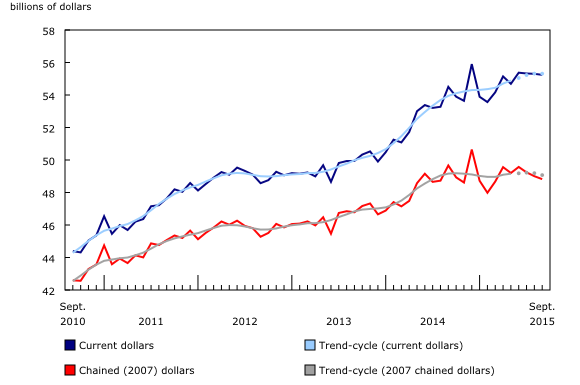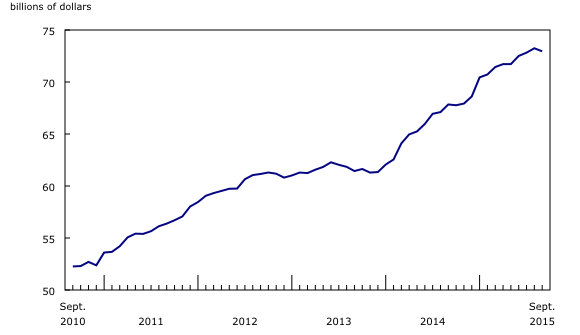Wholesale trade, September 2015
Archived Content
Information identified as archived is provided for reference, research or recordkeeping purposes. It is not subject to the Government of Canada Web Standards and has not been altered or updated since it was archived. Please "contact us" to request a format other than those available.
Released: 2015-11-19
$55.2 billion
September 2015
-0.1% 
(monthly change)
Wholesale sales edged down 0.1% to $55.2 billion in September. Declines in the motor vehicle and parts and the building material and supplies subsectors were partially offset by higher sales in the machinery, equipment and supplies and the food, beverage and tobacco subsectors.
Excluding the motor vehicle and parts subsector, wholesale sales rose 0.5%.
In volume terms, wholesale sales decreased 0.4% in September.
Lower sales in three subsectors
In September, lower sales were recorded in three subsectors, which together accounted for 45% of wholesale sales.
The motor vehicle and parts subsector recorded a third consecutive decline, down 3.0% to $9.8 billion in September. The motor vehicle industry accounted for most of the decrease, declining 3.9% to its lowest level in six months. In September, there were lower imports and exports of motor vehicles and parts as well as lower sales by motor vehicle assembly plants.
In the building material and supplies subsector, sales decreased 2.1% to $7.5 billion, their lowest level in seven months. The lumber, millwork, hardware and other building supplies industry contributed the most to the decline in the subsector, recording a 2.9% decrease that partially offset its gain in August. Imports and exports of lumber and other sawmill and millwork products were also lower in September.
Another contributor was the metal service centres industry (-3.7%), where sales decreased for a second consecutive month to reach their lowest level since October 2011.
The personal and household goods subsector recorded a third consecutive decline, edging down 0.1% to $7.8 billion, led by lower sales in the pharmaceuticals and pharmacy supplies industry (-1.2%).
Following a decline in August, sales in the machinery, equipment and supplies subsector rose 1.7% to $11.2 billion in September. The computer and communications equipment and supplies industry (+5.8%) led the gain, offsetting most of its 7.0% decrease in August. Imports of electronic and electrical equipment and parts were also higher in September after declining in August.
The farm, lawn and garden machinery and equipment industry was another contributor to the gain in the subsector, rising 5.0% to its highest level in five months. The construction, forestry, mining, and industrial machinery, equipment and supplies industry (-3.1%) partially offset these gains with its 8th decrease in 11 months.
Sales in the food, beverage and tobacco subsector rose 1.6% to $10.9 billion in September after two consecutive declines. The food industry (+1.7%) led the gain, bringing the industry and the subsector to their highest levels on record.
Sales down in half of provinces
Wholesale sales declined in five provinces in September. Alberta and British Columbia were the largest contributors to the decline.
Sales in Alberta decreased for the 9th time in 10 months, down 1.3% to $6.5 billion, their lowest level since June 2013. Declines were widespread across subsectors.
In British Columbia, sales declined 1.4% to $5.3 billion, offsetting most of their gain in August. In September, lower sales in the building material and supplies subsector led the decrease.
Following an 8.2% gain in August, sales in Saskatchewan decreased 0.9% to $2.3 billion. The agricultural supplies industry in the miscellaneous subsector contributed to the decline.
New Brunswick recorded a third consecutive decline, down 1.3% to $521 million, its lowest level since April 2014. The personal and household goods subsector was the largest contributor to the decline.
Both Quebec, up 0.8% to $10.0 billion, and Nova Scotia, up 5.2% to $807 million, recorded higher sales in September following two consecutive declines. The food, beverage and tobacco subsector led widespread gains in both provinces.
In Prince Edward Island, sales rose 5.5% to $64 million, offsetting most of their decline in August.
Inventories decline in September
Inventories decreased 0.4% to $73.0 billion in September, the first decline in 11 months. Decreases were reported in four of seven subsectors, representing 64% of wholesale inventories.
The machinery, equipment and supplies subsector (-1.5%) contributed the most to the decline in dollar terms, recording its first decrease since November 2014.
Inventories in the building material and supplies subsector declined 1.1%, a sixth consecutive decrease. The last time this subsector posted as many consecutive declines was in 2009, when inventories decreased for 10 consecutive months.
Higher inventories in the motor vehicle and parts subsector (+1.9%) partly offset the declines elsewhere; this was the fourth consecutive gain in the subsector.
The inventory-to-sales ratio was unchanged at 1.32 in September. The inventory-to-sales ratio is a measure of the time in months required to exhaust inventories if sales were to remain at their current level.
Note to readers
The public is also invited to chat with an expert on wholesale trade on Friday, November 27, 2015, from 12:30 to 13:30 p.m., Eastern time.
All data in this release are seasonally adjusted and in current dollars, unless otherwise noted. For information on seasonal adjustment, see Seasonally adjusted data – Frequently asked questions.
Total wholesale sales expressed in volume are calculated by deflating current dollar values using relevant price indexes. The wholesale sales series in chained (2007) dollars is a chained Fisher volume index with 2007 as the reference year. For more information, see Sales in volume for Wholesale Trade.
The Monthly Wholesale Trade Survey covers all industries within the wholesale sector as defined by the North American Industry Classification System (NAICS), with the exception of oilseed and grain merchant wholesalers (NAICS 41112), petroleum and petroleum products merchant wholesalers (NAICS 412) and business-to-business electronic markets, and agents and brokers (NAICS 419).
For more information on trend-cycle data, see the StatCan Blog and Trend-cycle estimates – Frequently asked questions.
Real-time CANSIM tables
Real-time CANSIM tables 081-8011, 081-8012 and 081-8015 will be updated on November 26. For more information, consult the document Real-time CANSIM tables.
Next release
Wholesale trade data for October will be released on December 18.
Products
The September 2015 issue of Wholesale Trade (63-008-X) will soon be available.
Contact information
For more information, contact us (toll-free 1-800-263-1136; 514-283-8300; STATCAN.infostats-infostats.STATCAN@canada.ca).
For analytical information, or to enquire about the concepts, methods or data quality of this release, contact Elspeth Hazell (613-951-8090; elspeth.hazell@canada.ca), Manufacturing and Wholesale Trade Division.
- Date modified:



